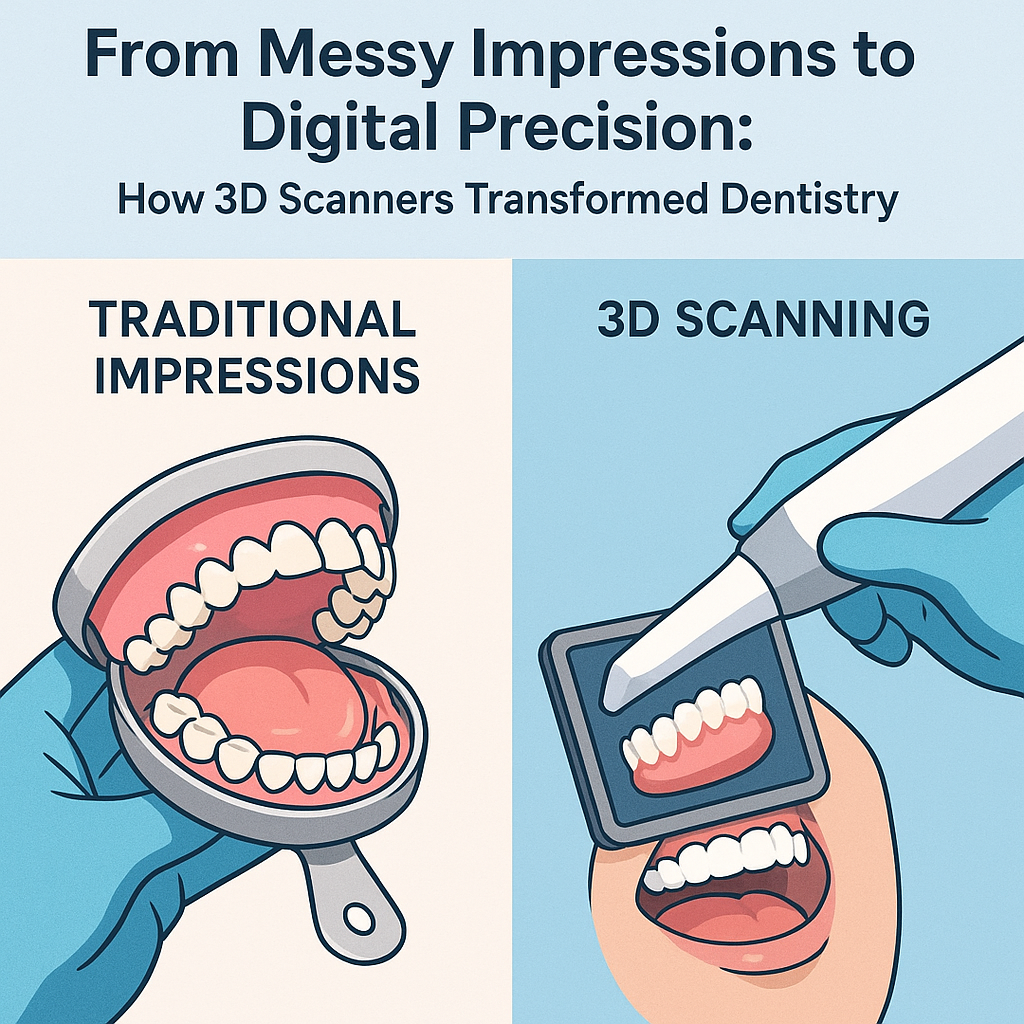You’ve probably seen claims like, “Our clinic uses cutting-edge techniques!” But what’s truly modern, and what’s already outdated? Let’s break it down using one of the most basic dental procedures—taking impressions.

Today, we’ll compare two approaches: traditional impressions and 3D scanning. What are the pros and cons of each? What’s still relevant, and what belongs in the past?
Traditional Impressions: Pros and Cons
Despite the growing popularity of 3D scanners, conventional impressions remain an essential tool in a dentist’s arsenal.
Pros of Traditional Impressions
- Affordability
Any new dentist can use this method without major equipment investments. - Simplicity
Taking impressions is a fundamental skill taught to all dental students and assistants. - High Accuracy
Modern materials achieve excellent detail—if conditions like dryness, stable temperature, and precision are maintained. - Versatility
Impression materials are used across various fields: therapy, orthodontics, prosthodontics, and implantology.
Cons of Traditional Impressions
No matter how much defenders praise them, this method has plenty of drawbacks:
- Patient Discomfort
Materials can cause pressure, unpleasant sensations, and even trigger a gag reflex. - Redo Attempts
If the impression fails, the process must be repeated—frustrating for the patient. - Time-Consuming
Processing, shipping to the lab, and fabricating the model take longer than digital methods.
3D Scanning: The Future is Already Here
3D scanners entered dentistry in the early 2000s, initially met with skepticism. High equipment costs, limited labs accepting digital files, and conservative dentists slowed adoption.
But technology advanced rapidly, and today, 3D scanning is the gold standard. Why?
Advantages of 3D Scanners
- Patient Comfort
The patient simply opens their mouth while the dentist gently moves the scanner—no pressure or discomfort. - Speed
Scanning is faster than traditional impressions. - Precision and Reliability
Digital tech minimizes risks of distortion or human error. - Digital Storage
All data is stored digitally, easily shared with labs or reused if needed. - Visualization and Planning
3D scans allow immediate previews of restorations and treatment planning. For example, Smile Design helps visualize a patient’s future smile.
Disadvantages of 3D Scanning
Of course, there are downsides:
- High Cost
Scanners start at €15,000, making them unaffordable for some clinics. - Training Required
Using a 3D scanner demands additional skills. - Limitations in Complex Cases
Scanning can be tricky with bleeding gums, intricate anatomy, or reflective surfaces.
Comparison Table: Traditional Impressions vs. 3D Scanning
| Criterion | Traditional Impressions | 3D Scanning |
|---|---|---|
| Patient Discomfort | High | Low |
| Speed | Slower | Faster |
| Accuracy | Material/technique-dependent | High |
| Cost | Cheaper | More expensive |
| Risk of Distortion | Possible | Almost none |
| Ease of Learning | Easy | Requires training |
| Data Storage | Physical impression | Digital files |
Which to Choose: Old or New?
Both methods remain relevant. The choice depends on the case, patient condition, and clinic capabilities. However, if a dentist uses a 3D scanner, it’s a sign of modern practice and tech investment.
Did You Know?
Beyond intraoral scanners (for in-mouth use), there are extraoral scanners. What are they, and where are they used? We’ll cover that in our next article!
Stay tuned to our blog to keep up with the latest in dental technology!